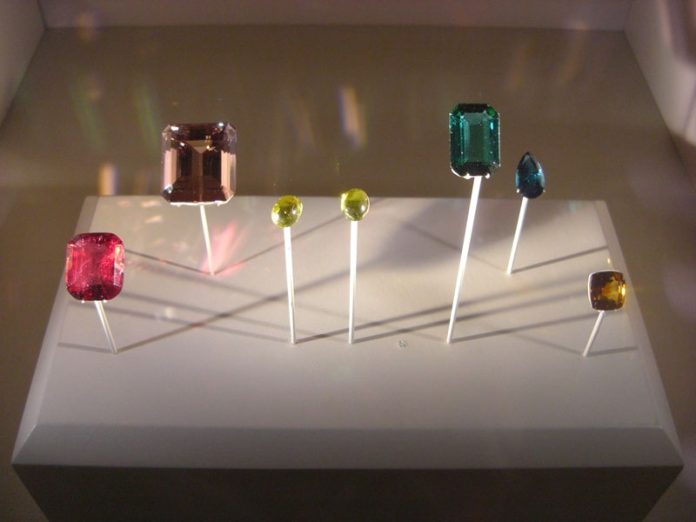
Having a GIA certification from the Gemological Institute of America on your resume signifies excellence within the gemstone community. It’s a certification people look for when seeking the best jeweler or gemstone appraiser. Here’s how to earn that label…
What is the Gemological Institute of America?
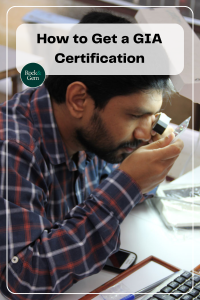
GIA is a private, nonprofit educational institute founded in 1931 by Robert Shipley to focus on research and education in gemology and jewelry arts to professionalize the business and raise a cadre of jewelers the public could trust. A jeweler himself in the 1920s, Shipley recognized deficiencies in his knowledge, so he undertook training in Europe via the Great Britain National Association of Goldsmiths gemological course. Back in the U.S., he made it his mission to build a community of like-minded professionals.
The institute undertakes research, publishes the quarterly journal Gems & Gemology, and provides important resources for the industry, including a laboratory, library and newly developed instruments for identifying and grading gemstones. For instance, it was GIA that crafted the indispensable 10x eye loupe and devised the famous “Four C’s” approach to evaluating and grading diamonds based on cut, clarity, color and carat weight. Research conducted within institute labs develops ever-better methods for identifying, evaluating and grading gemstones and detecting synthetics and treated stones.
Equally important, GIA offers courses, programs and accreditation.
Apply and Attend GIA Worldwide
The primary GIA campus and headquarters are in Carlsbad, California. It has a worldwide presence with some 3,000 employees and campuses, labs and/or research centers in 13 countries. It also has the GIA Global Leadership Program with the Harvard Business School.
To apply and enroll in programs or courses, you need at least a high school diploma or GED and must be at least 18 years old for on-campus attendance. However, exceptions can be made for applicants as young as 16 with a high school degree and a parental letter of approval.
GIA Certification Courses and Programs
GIA offers individual courses and diploma programs. Students get hands-on experience identifying and grading gemstones, using cutting-edge instruments, identifying synthetic or treated stones and understanding the jewelry and gemstone market. General areas covered include gemology, jewelry and jewelry design. Full programs include the following and more:
- Graduate Gemologist Program®
- Graduate Diamonds Program
- Graduate Colored Stones Program
- Graduate Jeweler Program
- Jewelry Design & Technology Program
- Comprehensive CAD/CAM for Jewelry Program
Programs vary in length. For instance, the Graduate Gemologist Program® is the most comprehensive. It combines the Graduate Diamonds and the Colored Stones Programs, involves taking five courses and three labs and takes 26 weeks to complete. On the other hand, the Comprehensive CAD/CAM for Jewelry Program takes just seven weeks to complete.
A Certification Journey
Louisa May Carey, a Graduate Gemologist®, started her journey with an Applied Jewelry Professional diploma that consists of three classes, then the Graduate Pearls diploma. She says she then “went full-bore” with the endgame of reaching Graduate Gemologist®. It consists of two prerequisites of Diamond Essentials and Colored Stones Essentials then moves on to Diamond and Diamond Grading and Colored Stones Grading, including an in-person lab class for each, and lastly Gem Identification. Each eLearning class is made up of chapters with a corresponding quiz and a final exam. The remaining Gem ID course is in the traditional chapter-andquiz format with the second half adding in 500 gems sent in batches of 20 each. You complete the stone identification course and then submit it to your instructor for review. Both homework and the 20 stone final (which you can take on campus or have proctored) require a passing grade of nothing less than 100 percent.
GIA certification courses and programs are accredited by both the Accrediting Commission of Career Schools and Colleges (ACCSC) and the Distance Education Accrediting Commission (DEAC). Beyond facts and skills, an equal focus is on instilling excellence, professionalism and high ethical standards.
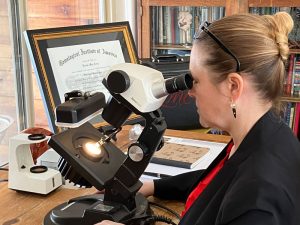
Courtesy Louisa May Carey
Study on Campus or at Home
Most GIA certification courses can be attended either on-campus or via eLearning, but—because of their inherent hands-on nature—all lab courses must be taken on campus. Students can attend on-campus courses at the headquarters in Carlsbad or in New York. As an example, in the U.S. you can earn the Graduate Gemologist® diploma by studying full-time on campus in either Carlsbad or New York, or you can earn the same diploma by taking the five required courses online (in a media-rich environment with flexible completion times and online exams) and the three lab courses on campus.
Even when studying online, students receive individualized attention. Louisa noted that one course in particular—Gem Identification—offered the most one-on-one instruction, but GIA instructors in all courses encouraged questions from students attending in-person or online. She especially liked the virtual Student Workroom. “If you are looking for more help or want to brush up on anything, the Student Workroom allows you to reserve a ‘seat’ for a half or full day with an instructor.”
Still, despite the flexibility of the online environment, Louisa found the in-person lab classes to be the best. “In general, eLearning is more solitary and you have to be very self-motivated. For me, not having the comradery of classmates and a group graduation at the end was the biggest drawback. But looking back, I will say not having the traditional classroom experience prepared me for what my current work is like.”
Louisa cautions that sticking with it once enrolled was not easy. “Having a distance education option is amazing. That being said, working full time, juggling homework and taking vacation time for the in-person lab classes, plus finding a place to stay within a budget…let’s just say you have to LOVE it!”
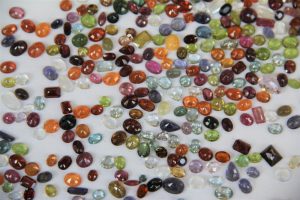 GIA Certification Costs & Financial Assistance
GIA Certification Costs & Financial Assistance
The cost of a GIA certification ranges. For instance, basic tuition ranges from a low of about $6,000 for a seven-week Jewelry Design program to a high of approximately $23,000 for the 26-week Graduate Gemologist® program.
Tables listing tuition for each program may be found in the GIA catalog and website. Those tables also provide estimates for the total “Cost of Attendance” (COA) for each program including housing, meals, transportation, books and supplies.
With its curricula approved by the U.S. Department of Education, students enrolled in on-campus programs are qualified to apply for Title IV federal financial aid. Qualifying students can also receive veteran benefits from the Department of Veterans Affairs. GIA itself offers scholarships to qualified students.
While some may look at the cost (especially total COA) and rethink, Louisa urges people to persevere, “Just like anything worth doing, before you do it there will never be enough time or money, but find a way. Investing in yourself will always be worth it.
Beyond the Courses
The research wing of GIA has invented many devices and instruments essential for gemstone testing and identification throughout its 90+ year history. Some of these are stocked in a campus store and available for students and professionals alike. Instruments range from simple tweezers and 10x loupes to spectroscopes, refractometers and polariscopes. A handy GIA Gem Identification Package, geared specifically to distance education students, provides devices for setting up a basic at-home gem testing and identification station. The store stocks books, classification charts and other print materials.
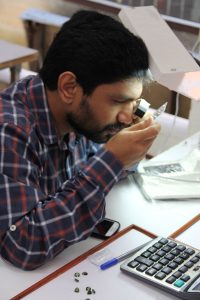 Benefits of a GIA Certification
Benefits of a GIA Certification
How does being GIA-certified help in the long run? Wherever you go, people buy and wear jewelry and seek authorities they can trust. GIA can help a budding jeweler become that authority and obtain the professional skills to move to the next level.
To the average person on the street, mention gems and they’ll think of the person behind the counter in a jewelry or department store, but there are many more paths. GIA has helped people go on to careers as appraisers (for individuals, insurance companies, law enforcement), in retail sales and as wholesale buyers, as designers and bench jewelers, in the manufacturing world, and in auction houses, museums, and research and lab-based settings.
For Louisa, she learned to use state-of-the-art equipment; how to troubleshoot; how to take a moment away when looking at something too long. “I loved learning to listen and find the ‘tell’ in a gemstone and learning that if I don’t know something, to say so and how to find out. GIA did that for me. It gave me confidence. It gave me a skill set. Being able to apply my knowledge in a real-world setting was also life-changing.”
GIA Career Support
To give graduates a leg up, the institute established GIA Career Services to advise on options and how to plan and navigate the way to a successful career. They maintain a worldwide database of job offerings in the jewelry industry and hold an annual Jewelry Career Fair in Carlsbad, New York and London.
Help from GIA doesn’t end with graduation and a job. Per Louisa, “in the last few years online lectures, like the wonderful weekly GIA Knowledge Sessions, have been created. Continuing education and conversation are more accessible than ever. As a working professional, I am thankful to have such valuable platforms at my fingertips now.”
As for Louisa’s continuing journey, after a stint at an award-winning California jewelry store, she has struck out on her own. “I recently took my confidence to a new level by moving back to my childhood home of Whitefish, Montana, and opening my own business, LMC Jewelry Appraisal. It is so scary but so fun.”
This story about GIA certification appeared in Rock & Gem magazine. Click here to subscribe. Story and photos by Jim Brace-Thompson.















